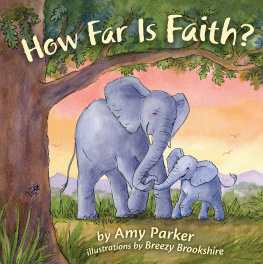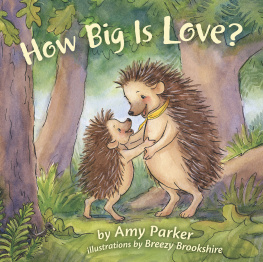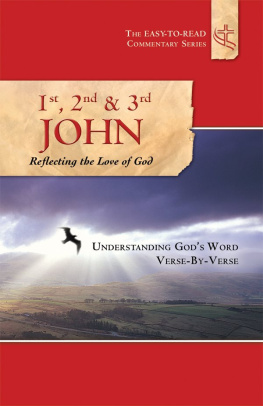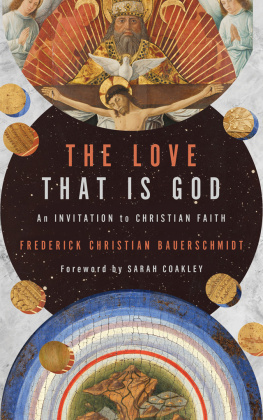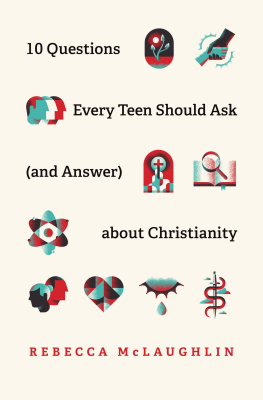A FEW YEARS AGO , I purchased a painting from a noted western artist. It depicts a lake in Wyomings Wind River Mountains in a cool blue palette that signals the connection between water, earth, and sky. The picture invites viewers into contemplation of natures reverie invoking both rest and renewal. When I first glimpsed the image in the art gallery, it literally drew me across the room. I knew that it was intended for me, as a beckoning icon of Gods beauty. It now hangs in my living room as a reminder and celebration of creation.
But there is something not quite right about the picture. It is in the wrong frame. While the painting exudes a sort of calm azure holiness, the frame is a gaudy gold. The frames edges are too wide and deflect attention away from the lake at the center, while its metallic sheen fights the subdued tones of the mountains. It appears as if the artist did not match the frame with the picture. Instead, he probably used the first frame from his storeroom that fit the paintings dimensions without thinking about the story the picture told. He took whatever was at hand and did not consider how it wouldor would notcomplement the image.
Every time I pass it on my living room wall, I think: I need to change that frame.
That is, of course, how many people now view the Christian faith. The picture painted by Jesus is a beautiful one of healing, abundance, and justice. It invites people into Gods grace and opens the eyes and heart to kindness, peace, and mercy in this life. Jesus was an artist of love and human flourishing; his canvas was the sacredness of the world. But something is wrong. It is as if the vision drawn by Jesus and intended for delight was put in the wrong frame. The structure around the picture and the picture itself are in conflict.
In these pages, Norman Wirzba reframes the painting. He reminds us that Christianitys focal point is a vision of Gods love that creates, sustains, and redeems the world. Then, in each succeeding chapter, Professor Wirzba carefully strips away layers of gaudy paint on the four sides of the old frameCreation, Fall, Salvation, and Heavenand reworks and reuses the old pieces to construct a new frame that directs our attention back to the center of the canvas. In the process, both the painting and the frame spring to life as a way of love that draws readers into a greater sense of meaning and joy. And Christianity emerges from encrustations of doctrinal rigidity and institutional regulation as a path of the heart.
There will be some who think that both the painting and the frame are the problem. And others who think that Christianity needs a completely new frame and none of the old bits can be repurposed. These are conversations and arguments that the church needs to have. But, in the meanwhile, many Christians are longing for the old, old story to be told in a new, new way. And by recycling and refinishing the frame, Norman Wirzba demonstrates that the painting may not be the problem at all. It is possible to make all things new by reframing that which The Artist always intended: that love is the all in all.
For those of us who have known that we need to change the frame, Way of Love is a gift. It enables us to seeand experiencethe painting afresh.
Diana Butler Bass
Alexandria, Virginia
Whoever does not love abides in death.
1 J OHN 3:14
D OES C HRISTIANITY STILL MATTER ? Arent we better off without this archaic religion and its sectarian squabbles and divisive politics? Why even bother with God when it is clear that the idea of God is the basis for so much pain and hurt in the world?
This book is my attempt to answer these questions and to argue that Christianity very much still matters. Well, to be more precise, I will argue that the Christian faith can and should be taken seriously, provided that we rediscover Christianitys heart.
Christianity matters because it reveals the deep mysteries of God and the meaning of all life. It shows us what life is for and when it is at its best. And what is this ultimate revelation? The answer is surprisingly and profoundly simple: Christianity reveals the life of God and therefore also the meaning of life as a way of love. God, life, and lovethese three are indispensable for a good and beautiful world. Without these three together, everything falls apart. That is the heart of Christianity, and that is the message we most need to recover.
This revelation about love is not obvious. One only has to point to the fact that we live in a world too much acquainted with loves oppositeshatred and violence, boredom and fatigueto affirm loves centrality. Histories of war, genocide, and now ecocide suggest that love is rarely the ideal that inspires human hope and action. Doesnt the barbarity and indifference of just the last century, a century when we thought wed finally behave at our enlightened best, only to devise and carry out unprecedented levels of killing one another, teach us that the reality of God and the life of love are delusions?
Moreover, a quick look at Christianitys history and some of its contemporary expressions demonstrates that Christians have not always lived out their faith as a way of love. In fact, the church has at times shown itself as the enemy of love. This is at the heart of the crisis in the church today and explains why so many people have chosen to stay away or drop out. Christian leaders and their followers have often distorted love by turning it into a possession reserved primarily for themselves or those they deem worthy. By turning love into a stick used to exclude or punish otherswomen, children, minorities, foreigners, homosexuals, the homeless, criminals, or handicapped individuals have each had a turn at being the unwelcome otherChristians have often unleashed hatred into the world, not love. Christian-inspired hatred, however, is a theological catastrophe and a failure of massive proportions, since it runs counter to what the Bible explicitly teaches: Those who say, I love God, and hate their brothers or sisters, are liars; for those who do not love a brother or sister whom they have seen, cannot love God whom they have not seen (1 John 4:20).
But recognizing the harsh realities of this world and pointing out how the church falls short of its ideals do not mean those ideals are wrong. No, my claim is that it is precisely these shocking experiences of the opposites of love that teach us that life needs love to lift existence out of the quagmire of neglect and brutality. Without love, life becomes a more or less tolerable descent into death. To give up on love is also to give up on the world and each other.
Additionally, love needsGod to expose and explode the often anxious, often self-serving desires that are loves pretenders. After two thousand years it is easy to overlook just how revolutionary the gospel of Jesus Christ really is. The God revealed in Jesus of Nazareth introduces us to forms of love that turn customary ways of ordering life upside down and inside out, showing us that what people think about love is often far too narrow and far too small. Insofar as Jesus inspires genuine love in the world, life becomes an adventure in the ways of solidarity and celebration. Love is the crucial thing, because it is love that separates the ways of life from the ways of death.


